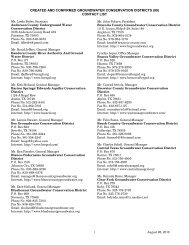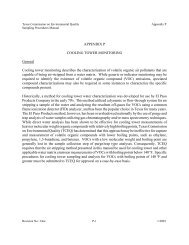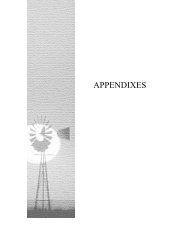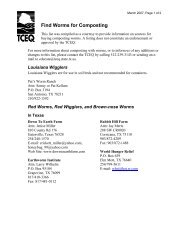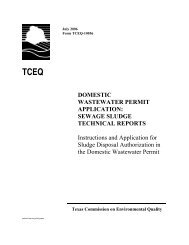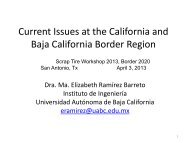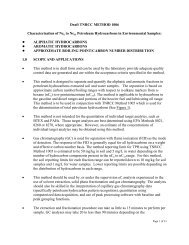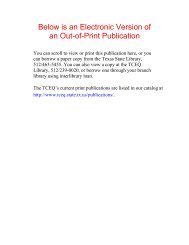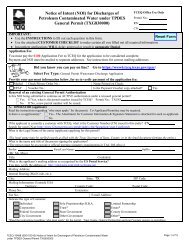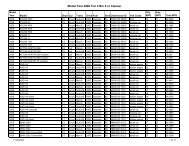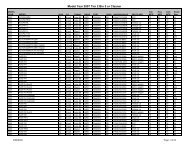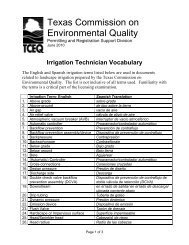Ecological Overlay for the Trinity River for support of Development of ...
Ecological Overlay for the Trinity River for support of Development of ...
Ecological Overlay for the Trinity River for support of Development of ...
You also want an ePaper? Increase the reach of your titles
YUMPU automatically turns print PDFs into web optimized ePapers that Google loves.
Introduction<br />
This report summarizes available ecological in<strong>for</strong>mation on <strong>the</strong> <strong>Trinity</strong> <strong>River</strong> and provides an<br />
“<strong>Ecological</strong> <strong>Overlay</strong>” document <strong>for</strong> future development <strong>of</strong> instream flow recommendations <strong>for</strong><br />
<strong>the</strong> <strong>Trinity</strong> <strong>River</strong>. This summary report includes graphical representations and tabular<br />
in<strong>for</strong>mation revealing key relationships between flow variation and <strong>the</strong> ecological indicators.<br />
This also include a species occurrence matrix indicating, when available, <strong>the</strong> location <strong>of</strong> various<br />
fish and aquatic species within <strong>the</strong> basin by river mile, TCEQ waterbody code, HUC code and<br />
latitude and longitude. This was developed in coordination with San Jacinto <strong>River</strong> Authority and<br />
o<strong>the</strong>r investigators in Texas who are conducting similar studies. Supporting graphical and<br />
tabular data are available in digital <strong>for</strong>mat from <strong>the</strong> <strong>Trinity</strong> <strong>River</strong> Authority and/or Texas Water<br />
<strong>Development</strong> Board with a copy <strong>of</strong> <strong>the</strong> full summary report.<br />
Data used in <strong>the</strong> preparation was extracted from various sources including published peer<br />
reviewed articles, agency reports, federal aid progress reports, conference proceedings, and<br />
regional, state and federal environmental databases. The focus <strong>of</strong> this study was on development<br />
<strong>of</strong> ecological in<strong>for</strong>mation on <strong>the</strong> occurrence and relationship <strong>of</strong> instream living resources and<br />
hydrology. However, two related study objectives were also included in <strong>the</strong> scope <strong>of</strong> work. This<br />
included developing background data on important variables processes needed to understand <strong>the</strong><br />
influence <strong>of</strong> changing hydrology on water quality and <strong>the</strong> physical transport <strong>of</strong> sediments.<br />
There<strong>for</strong>e an attempt was made to evaluate <strong>the</strong> fluctuation <strong>of</strong> important water quality parameters<br />
(water temperature, conductivity, dissolved oxygen, selected nutrients and suspended solids in<br />
relation to flow, including loading estimates at selected priority gages. In addition we have<br />
provided estimates <strong>of</strong> downstream loading <strong>of</strong> nutrients and suspended solids to <strong>the</strong> estuary from<br />
<strong>the</strong> <strong>Trinity</strong> <strong>River</strong>. Two major products produced from this study include a species occurrence<br />
matrix which utilized data compiled from surveys <strong>of</strong> <strong>the</strong> literature including agency reports, and<br />
summarization <strong>of</strong> ecological relationships <strong>of</strong> candidate “focal species” previously suggested by<br />
TPWD. These focal species were compared, based on <strong>the</strong>ir life history attributes, to o<strong>the</strong>r<br />
members <strong>of</strong> <strong>the</strong> fish community to determine if <strong>the</strong>y can serve as indicator species representing<br />
larger ecological fish guilds. Finally using <strong>the</strong>se indicator species generic and specific<br />
recommendations on possible instream flow regimes is presented. This data can be used to<br />
in<strong>for</strong>m current and future hydrological analysis generated by IHA/HEFR/MBFIT to prescribe<br />
recommend flow regimes <strong>for</strong> conservation and protection <strong>of</strong> <strong>the</strong> ecological health <strong>of</strong> <strong>the</strong> river.<br />
Although o<strong>the</strong>r biological data exist on benthic communities and wildlife, by far more<br />
in<strong>for</strong>mation exists on <strong>the</strong> fish communities <strong>of</strong> <strong>the</strong> <strong>Trinity</strong> <strong>River</strong> basin. This is due in part to <strong>the</strong>ir<br />
cultural and economic importance as a fisheries resource and <strong>the</strong> more extensive history <strong>of</strong><br />
research and monitoring by state agencies and university researchers. The primary sources <strong>of</strong><br />
data include fisheries and river fish community studies by Texas Parks and Wildlife Department<br />
during <strong>the</strong> last 40 years and recent investigations by TCEQ and predecessor agencies conducting<br />
water quality related permitting studies including receiving water assessments. In addition, EPA<br />
and TCEQ have funded additional university studies investigating <strong>the</strong> effects <strong>of</strong> water quality on<br />
biota. Comparatively few data and studies exist on invertebrate and wildlife resources.<br />
15<br />
Environmental Institute <strong>of</strong> Houston<br />
November 17, 2009<br />
<strong>Trinity</strong> <strong>River</strong> Basin<br />
Biological <strong>Overlay</strong>



